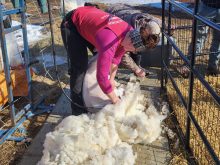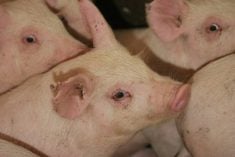A search for better lambs has led to the development of a lamb test project.
Unlike test stations that use only premier animals, this research project will match five breeds of rams with Lakeland College’s generic sheep flock, said Sue Hosford, Alberta Agriculture’s business development specialist and the driving force behind the project.
While some sheep producing countries have flocks that are as even as peas in a pod, the Canadian sheep flock is made up of 40 breeds and the lambs they produce are of varying size and quality, just like the 150 head flock at Lakeland College.
Read Also

Charges laid after cattle theft
Saskatchewan RCMP lay two charges against a man after six cattle went missing.
“They were a Heinz 57, typical of flocks in Western Canada,” Hosford said.
The project goal is to see which breed of rams is the best match for Western Canada’s sheep flocks and produces the best product for the grocery store market.
“We’ve never had a study that looks at retail yield,” Hosford said.
The project was initiated after Sunterra Meats of Innisfail, Alta., introduced a pricing grid in 2004 with a premium price paid for quality. About 20 percent of the lambs brought to the plant received the higher premium, but the largest percentage fell into the average quality, said Miles Kliner, general manager of Sunterra Meats, which is the largest lamb processor in Western Canada.
“They’re not poor but not as good as could be,” Kliner said.
However, a high-value lamb market first requires high-value lambs.
“We still needed more of a specialized type of lamb,” said Hosford.
Alberta used to have a ram test station at Olds, but it was closed in the mid-1990s. Breeders then banded together to develop a western sire reference program to receive data on their flocks.
Most of the existing data on sheep was limited to the Suffolk breed but the test station at Lakeland will compare Suffolk, Texel, Canadian Arcott, Ile de France and Charollais.
The goal is to test a specific breed of sheep rather than a genetic line. Each of the rams of each breed comes from different genetic lines.
“We don’t want a ram effect, but a breed effect,” Hosford said.
Breeders in other provinces have also been asked to supply rams of the same breed, but with different genetics, for the second year of the project. About 50 rams will be used during the two-year project.
Kliner said if Sunterra wanted a higher quality of lamb, it needed to work with a research project that would help producers identify rams that would allow them to produce a more consistent quality without replacing the entire flock.
“We work on projects all the time. Very rarely do you get involved in a project that has real potential to benefit the industry,” Kliner said.
“We now have to provide information to producers on how to achieve those higher quality lambs.”
The lambs will be slaughtered at Sunterra and the retail yield of each animal will be assessed.
This fall 60 lambs from Agriculture Canada’s research centre in Lethbridge were sent to Sunterra to help develop the model that will be used to measure retail meat yield. About 600 lambs will be evaluated over the two years of the project.
“If we want to improve conformation in lambs, this is critical information,” Hosford said.
















